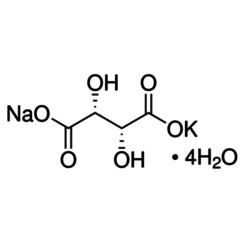You have no items in your shopping cart
Potassium sodium tartrate
Potassium sodium tartrate tetrahydrate, also known as Rochelle salt, is a double salt of tartaric acid first prepared (in about 1675) by an apothecary, Pierre Seignette, of La Rochelle, France. Potassium sodium tartrate and monopotassium phosphate were the first materials discovered to exhibit piezoelectricity. This property led to its extensive use in "crystal" gramophone (phono) pick-ups, microphones and earpieces during the post-World War II consumer electronics boom of the mid-20th Century. Such transducers had an exceptionally high output with typical pick-up cartridge outputs as much as 2 volts or more. Rochelle salt is deliquescent so any transducers based on the material deteriorated if stored in damp conditions.
It has been used medicinally as a laxative. It has also been used in the process of silvering mirrors. It is an ingredient of Fehling's solution (reagent for reducing sugars). It is used in electroplating, in electronics and piezoelectricity, and as a combustion accelerator in cigarette paper.
In organic synthesis, it is used in aqueous workups to break up emulsions, particularly for reactions in which an aluminium-based hydride reagent was used. Sodium Potassium tartrate is also important in the food industry.
It is a common precipitant in protein crystallography and is also an ingredient in the Biuret reagent which is used to measure protein concentration. This ingredient maintains cupric ions in solution at an alkaline pH.


